Wat zijn de 4 C’s van diamanten?
Title:
De 4C's zijn universeel erkend en vormen een leidraad in de wereld van diamanten. Ze bepalen mede de kwaliteit en waarde van elke steen: de 4C's staan voor color, cut, carat en clarity. De laboratorium-diamanten uit de Swarovski Created Diamond-collecties worden beoordeeld op basis van deze 4 C's door IGI, het International Gemological Institute. De laboratorium-diamanten in deze collecties zijn van zeer goede kwaliteit: G+ in kleur en VS+ in helderheid.
Helderheidsprincipes en -factoren
Title:
De helderheid van een laboratorium-diamant wordt beoordeeld aan de hand van de gebreken, dat wil zeggen de insluitsels en onzuiverheden die de diamant zijn unieke karakter en charme geven. Ontdek hieronder meer over de helderheid van diamanten.
I.F.
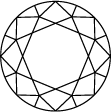
Internally flawless (intern foutloos)
VVS 1
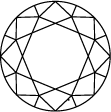
VVS 2
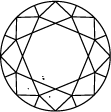
Very very slightly included (heel erg kleine inclusie)
VS 1
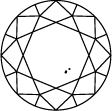
VS 2

Very slightly included (zeer geringe inclusie)
SI 1

SI 2

Slightly included (lichte inclusie)
I 1

I 2
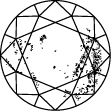
I 3

Included (insluitsel)
Helderheidstabel voor diamanten
Title:Helderheidstabel en cijfers voor diamanten
Subtitle:
De helderheidstabel van diamanten loopt van I.F. tot I 3 en is gebaseerd op het aantal insluitsels en oneffenheden die in elke steen gevonden worden. De helderheidsgraad van diamanten wordt bepaald onder standaardomstandigheden met een vergroting van 10x. I.F. wordt gebruikt voor een intern foutloze diamant. Aan het andere uiteinde van de helderheidsschaal staat I 3 voor een zichtbare onzuiverheid. Echt foutloze diamanten zijn uiterst zeldzaam; bijna alle stenen, inclusief laboratorium-diamanten, hebben insluitsels van welke aard dan ook.
Kleurprincipes en -factoren
Title:
De kwaliteit van een laboratorium-diamant is gebaseerd op zijn grootte, symmetrie en glans. Een vakkundige slijpvorm creëert een veelheid aan facetten, die het licht absorberen en weerspiegelen zodat de steen vanuit elke hoek schittert.
Colorless
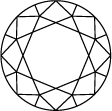
D-F
Near colorless
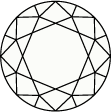
G-J
Slightly tinted
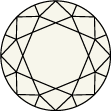
K-M
Very light color

N-R
Light color
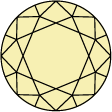
S-Z
Diamond color scale and chart
Diamond coloring is rated on a scale from D to Z, with D clear ice white with no hint of yellow, while those rated Z are shades of yellow and brown. Each letter range on the chart denotes a shade of stone, with those rated D to F appearing colorless, through to S to Z appearing in shades of light yellow or brown. Swarovski only accepts the finest laboratory grown diamonds in its collections, meaning they range from colorless to nearly colorless diamonds (D-G).
Color Principles and Factors
Title:
Colorless stones are the most desirable in the world of diamonds and they are extremely rare. Swarovski Created Diamonds are evaluated against the standardized diamond color scale.

2.5 mm
0.05 CT

3.0 mm
0.10 CT

3.8 mm
0.20 CT

4.5 mm
0.30 CT

4.8 mm
0.40 CT

5.2 mm
0.50 CT

5.8 mm
0.70 CT

6.3 mm
0.90 CT

6.5 mm
1.00 CT

6.9 mm
1.25 CT

7.4 mm
1.50 CT

7.8 mm
1.75 CT

8.2 mm
2.00 CT

8.8 mm
2.50 CT

9.4 mm
3.00 CT
Diamond Carat Weight
Title:Laboratory Grown Diamond Carat Scale
Subtitle:
The carat measurement is derived by the word ‘carob’, a seed that was used as a diamond weight reference for traders in the ancient world. Carats are an international standard unit of measurement for the weight of a diamond. One carat is equal to 200 milligrams, so a 5 carat diamond will weigh one gram. The diamond carat does not refer to the size of a stone, simply how much it weighs. Diamonds usually become more expensive as their carat increases.
Discover Swarovski Created Diamonds
All About Swarovski Created Diamonds
Title:Laboratory Grown Diamonds
Subtitle:
Discover the world of Swarovski Created Diamonds jewelry, redefining the future of diamonds with exceptional collections that bridge the gap between tradition and current trends. From the otherworldly brilliance of our interstellar collection to the pure elegance of our signature pieces, find a style that will last a lifetime.
Laboratory Grown Diamonds Buying Guide
Title:Find the perfect piece
Subtitle:
A natural progression of our brand DNA, Swarovski Created Diamonds jewelry are laboratory grown diamonds, masterfully cut, intensely bright, and identical to their mined counterparts in every way but origin. Formed layer by layer from a carbon seed, they serve as a flawless reflection of nature’s radiance.
What are Laboratory Grown Diamonds?
Title:Laboratory Grown Diamonds explained
Subtitle:
Find out more about diamonds that are grown in a laboratory, and how the process of replicating the way diamonds are formed in the earth is achieved. Discover the different cuts of diamonds in the Swarovski Created Diamond Collections, as well as the inspiration behind the designs.
Frequently asked questions
Diamond 4Cs FAQs
What are the 4Cs?
Every diamond varies slightly from the next and has its own individual distinguishing characteristics. Laboratory grown diamonds are 100% diamonds, and just like mined diamonds our laboratory grown diamonds are evaluated according to the 4Cs of diamond grading. The 4Cs are color, clarity, cut and carat weight, and they are the globally accepted standards used to assess the quality of diamonds.
Is diamond clarity important?
The higher the clarity grading, the less inclusions or blemishes a diamond has, making it a higher-value diamond than one with a lower grading.
What is the highest diamond clarity?
Diamond clarity is a measure of the purity of the stone graded by the visibility of two types of characteristics - inclusions and blemishes.
In order to assess clarity, the diamond is inspected under 10x power magnification. The number and nature of external (blemishes), and internal characteristics (inclusions), as well as their size and position, determine the grade.
Gemologists grade diamonds from Internally Flawless (IF) as the highest quality to Included (I3).
In order to assess clarity, the diamond is inspected under 10x power magnification. The number and nature of external (blemishes), and internal characteristics (inclusions), as well as their size and position, determine the grade.
Gemologists grade diamonds from Internally Flawless (IF) as the highest quality to Included (I3).
Are laboratory grown diamonds flawless?
No, nearly all diamonds (mined or laboratory grown) have inclusions. Metallic inclusions can occur in laboratory grown diamonds. If an expert spots a trace of metal in a diamond, they can assume it is laboratory grown. While laboratory grown diamonds with defects do exist, Swarovski only uses high quality laboratory grown diamonds certified by the International Gemological Institute (IGI) according to the 4Cs to ensure that only the finest quality diamonds join the Swarovski Created Diamond collections.
Do laboratory grown diamonds get cloudy?
No, laboratory-grown diamonds do not get cloudy over time. They are 100% identical to diamonds with the same physical and chemical properties, and should not degrade or change appearance over time. Where poor quality diamond seeds have been used, some laboratory-grown diamonds contain obvious defects, such as color tinges from impurities in the diamond or crystal structure imperfections. The laboratory grown diamonds processed in Swarovski Created Diamonds jewelry are a very high quality standard and do not have unnatural, problematic characteristics.
How are laboratory grown diamonds certified and graded?
The laboratory grown diamonds processed in Swarovski Created Diamonds jewelry are hand-selected and examined by experienced gemologists to ensure they fulfill our high quality standards. Every piece of jewelry in the Galaxy and Eternity collections is accompanied with a digital laboratory report from the International Gemological Institute (IGI).
What are diamond facets?
Diamond facets refer to each flat surface that creates the shape of a diamond. Every diamond possesses multiple facets that enable it to absorb and reflect light.
How is diamond cut quality determined?
We often think of a diamond’s cut as shape (round, heart, oval, marquise, pear), but what diamond cut actually does mean is how well a diamond’s facets interact with light. The cut of a diamond is the measure of the quality of the shape, geometry and finish of the diamond. Round brilliant diamonds receive a formal cut grade on a scale from Ideal (the best) to Poor. Swarovski is uncompromising on cut quality to ensure all of our laboratory grown diamonds have optimal light performance and sparkle.
What is the best diamond cut?
Cut refers to how a diamond’s facets interact with light to reveal its internal fire. It is the cut that gives each diamond its personality, and perfecting laboratory grown diamonds proportions, symmetry, and precision-cut angles of Swarovski Created Diamonds gives them their brilliant shine. The best cut has a balance between the width and depth to create symmetry, neither to shallow nor to deep. Creating the perfect refraction point for light through the diamond, reflecting it within the diamond and highlighting its polished brightness.
How is a diamond’s color determined?
Color refers to the natural tint inherent in white diamonds. The industry standard for grading color is to evaluate each diamond against a master set then assign a letter grade from D (colorless) to Z (light yellow).
The closer the diamond is to being colorless, the higher its quality.
The closer the diamond is to being colorless, the higher its quality.
Do laboratory created diamonds have blemishes?
Where poor quality diamond seeds have been used, some laboratory-grown diamonds contain obvious defects, such as color tinges from impurities or structural imperfections. Swarovski does not sell laboratory grown diamonds with unnatural, problematic characteristics.
What is diamond carat weight?
A carat is a unit of weight used specifically to measure precious stones including laboratory grown diamonds. A diamond may have a higher carat weight without appearing larger, and two diamonds of the same carat weight can vary in size if one is cut deeper than the other. One carat weighs 1/5 of a gram and is divided into 100 points.
What is the carat weight of a diamond, how is it measured and how important is it?
Carat weight it the standard weight unit for diamonds, and the first step in the grading process. Diamond carat weight is the measurement of how much the diamond weighs. Each carat can be subdivided into 100 “points.” This allows precise measurements to the hundredth decimal place. The weight of a diamond smaller than one carat may be described by its “points” alone. The larger the diamond is, the more carats it will be, but only you can decide how important that is to you.
Is it better to have a higher carat diamond?
This is an entirely personal question. If you are looking for a larger diamond, you should look for a higher carat, as this indicates the weight and therefore the size of the diamond.






